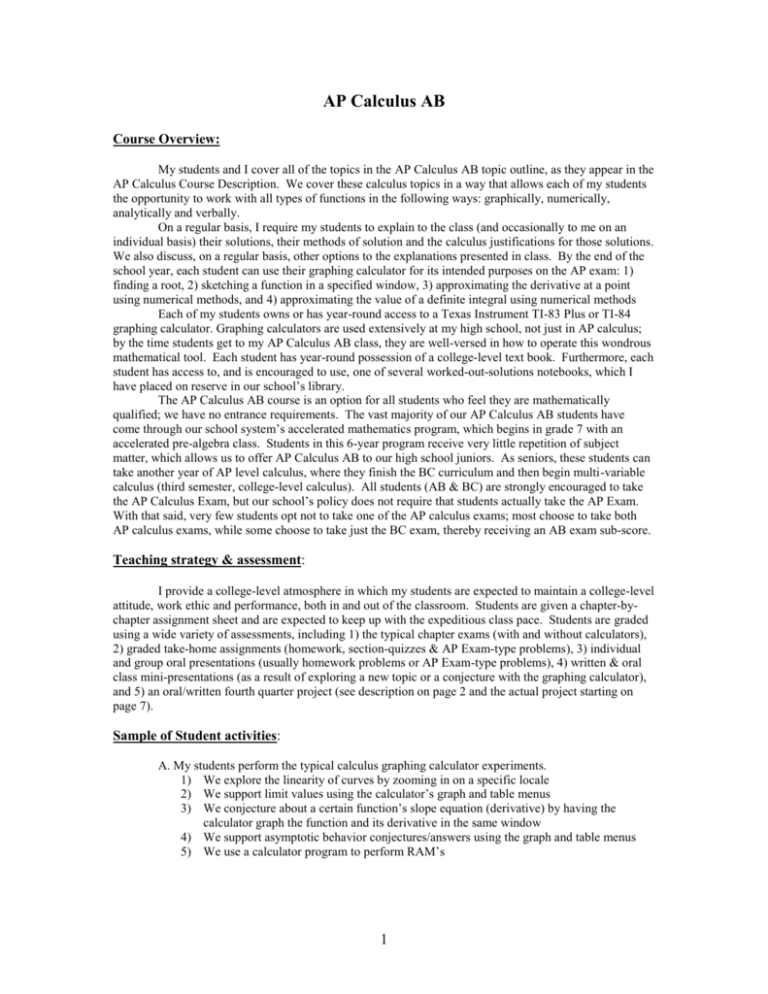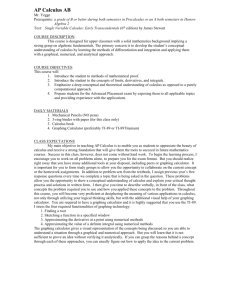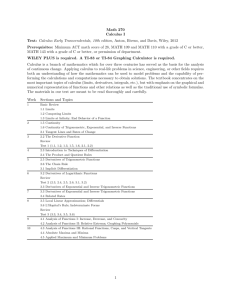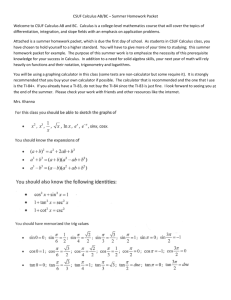
AP Calculus AB
Course Overview:
My students and I cover all of the topics in the AP Calculus AB topic outline, as they appear in the
AP Calculus Course Description. We cover these calculus topics in a way that allows each of my students
the opportunity to work with all types of functions in the following ways: graphically, numerically,
analytically and verbally.
On a regular basis, I require my students to explain to the class (and occasionally to me on an
individual basis) their solutions, their methods of solution and the calculus justifications for those solutions.
We also discuss, on a regular basis, other options to the explanations presented in class. By the end of the
school year, each student can use their graphing calculator for its intended purposes on the AP exam: 1)
finding a root, 2) sketching a function in a specified window, 3) approximating the derivative at a point
using numerical methods, and 4) approximating the value of a definite integral using numerical methods
Each of my students owns or has year-round access to a Texas Instrument TI-83 Plus or TI-84
graphing calculator. Graphing calculators are used extensively at my high school, not just in AP calculus;
by the time students get to my AP Calculus AB class, they are well-versed in how to operate this wondrous
mathematical tool. Each student has year-round possession of a college-level text book. Furthermore, each
student has access to, and is encouraged to use, one of several worked-out-solutions notebooks, which I
have placed on reserve in our school’s library.
The AP Calculus AB course is an option for all students who feel they are mathematically
qualified; we have no entrance requirements. The vast majority of our AP Calculus AB students have
come through our school system’s accelerated mathematics program, which begins in grade 7 with an
accelerated pre-algebra class. Students in this 6-year program receive very little repetition of subject
matter, which allows us to offer AP Calculus AB to our high school juniors. As seniors, these students can
take another year of AP level calculus, where they finish the BC curriculum and then begin multi-variable
calculus (third semester, college-level calculus). All students (AB & BC) are strongly encouraged to take
the AP Calculus Exam, but our school’s policy does not require that students actually take the AP Exam.
With that said, very few students opt not to take one of the AP calculus exams; most choose to take both
AP calculus exams, while some choose to take just the BC exam, thereby receiving an AB exam sub-score.
Teaching strategy & assessment:
I provide a college-level atmosphere in which my students are expected to maintain a college-level
attitude, work ethic and performance, both in and out of the classroom. Students are given a chapter-bychapter assignment sheet and are expected to keep up with the expeditious class pace. Students are graded
using a wide variety of assessments, including 1) the typical chapter exams (with and without calculators),
2) graded take-home assignments (homework, section-quizzes & AP Exam-type problems), 3) individual
and group oral presentations (usually homework problems or AP Exam-type problems), 4) written & oral
class mini-presentations (as a result of exploring a new topic or a conjecture with the graphing calculator),
and 5) an oral/written fourth quarter project (see description on page 2 and the actual project starting on
page 7).
Sample of Student activities:
A. My students perform the typical calculus graphing calculator experiments.
1) We explore the linearity of curves by zooming in on a specific locale
2) We support limit values using the calculator’s graph and table menus
3) We conjecture about a certain function’s slope equation (derivative) by having the
calculator graph the function and its derivative in the same window
4) We support asymptotic behavior conjectures/answers using the graph and table menus
5) We use a calculator program to perform RAM’s
1
B. My students go to the chalkboard/overhead and challenge each other to draw curves (functions)
with certain properties (discontinuities, increasing/decreasing intervals, concavity, plateau &
inflection points, intercepts, absolute & relative values, critical points, etc) which are delineated
by the students in precise calculus terms.
C. Students construct a box with maximum volume given a particular rectangle.
D. Students find the optimum dimensions of a cylinder with a given volume and then explain why
most cylinders are not constructed with optimum dimensions.
E. Students are encouraged to use their artistic talents or enlist the artistic talents of their friends to
sketch and then show the various solids of revolution, along with how to find its volume.
F. Students bring in molding clay or Play-Dough to build solids of rotation and solids with a
certain cross-section.
G. As an end-of-the-class time-filler, students challenge each other on a one-against-one or a
two-against-two basis to:
1. draw a slope field graph from a list of carefully selected differential equations
2. do an optimization problem from a list of problems
3. find special points (critical, inflection, plateau, etc) given certain types of functions
4. write a concise and succinct 9-point free-response solution to an AP question, which
would be similar in nature to an AP problem we had previously done in class
5. answer 10 multiple-choice AP Exam questions within 10 questions (the problems are
grouped as to type, so that they are all similar in nature)
Final Unit: Post-AP Calculus AB Exam Summary Project
(3 weeks)
After the AP Examination, each AP calculus student is given a carefully selected rational function
to analyze as a fourth quarter project. Using AP calculus techniques, each student writes a calculus-based
summary for each section of the project according to the project’s directions and rubric (at the end of this
report is the project/rubric/functions). Based on their particular rational function, each student will perform
the necessary review & research, analyze the function, discuss the mathematics with other students, and
then write a summary/conclusion.
The major AP calculus AB topics are included in this project: 1) continuity, limits & end behavior;
2) derivatives & their applications to curve analysis and to optimization; 3) the major theorems; 4) integrals
& RAM’s to accumulate area; and 5) using the graphing calculator as a tool to help verify/support graphs,
solutions and conjectures.
As a result of this project, I expect that 1) each student will better understand how the basic
concepts of AP calculus AB all fit together, 2) each student will be better able to verbalize and write about
the concepts of the calculus each has studied, and 3) each student will have a better understanding of a
graphing calculator’s use as an important tool in their mathematics toolbox.
Course Planner
Unit 1: Precalculus Review: (3 weeks)
A. Lines
a.
b.
c.
Slopes as rates of change
Parallel & perpendicular lines
Equations of lines and their proper applications
1. Linear regressions
B. Basic functions
a. Functions
1. Interval notation
2. Domain (restricted & natural/implied) and range
2
b.
Properties of functions
1. Symmetry
2. Even-odd
3. One-to-one
4. Vertical & horizontal line tests
c. Graphs, properties & transformations of the basic functions
d. Piece-wise defined functions
e. Function operations
f. Function compositions
C. Exponential & logarithmic functions
a. Exponential functions & their properties
1. Exponential growth & decay problems
b. Inverse functions
c. Logarithmic functions & their properties
1. Common & natural logarithms
2. Operation rules of logarithms
d. Base e & other bases with exponentials & logarithms
D. Trigonometric Functions
a. Radian measure & the unit circle
b. Graphs of the trigonometric functions
1. Domain, range, periodicity
2. Transformations
3. Inverse trigonometric functions
c. Trigonometric identities
d. Applications to periodic data
1. Graphing calculator problems using real-world data
E. Graphing calculator – ongoing all year
a. Used for graphing functions, for verification of solutions, for developing and
exploring mathematical premises, for supporting analytical solutions and
conclusions, and for performing calculus operations not possible or practical by hand
Unit 2: Limits & Continuity (3 weeks)
A. Rates of change
a. Average vs. instantaneous
B. Limits at a point
a. Properties of limits
b. Two-sided limits
c. One-sided limits
C. Limits involving infinity
a. Asymptotic behavior
1. Horizontal, vertical, oblique
b. End behavior models/asymptotes
c. Properties of limits
d. Visualizing limits using a graphing calculator’s table & graph menus
e. Discussions, with an emphasis on using correct vocabulary, about limits
D. Continuity
a. Continuous and discontinuous functions
1. Removable discontinuities
2. Jump discontinuities
3. Infinite discontinuities
b. Intermediate value theorem
3
Unit 3: The Derivative (6 weeks)
A. Definition of the derivative
a. Tangent to a curve
b. Slope of a curve at a point
c. Derivative notations and their proper uses
B. Differentiability
a. Local linearity
b. Numeric derivatives using a graphing calculator: nDer(
i. Discussion of when its use is appropriate and when it’s not
c. Differentiability and continuity
d. Where and why derivatives fail to exist
C. Derivative rules for algebraic functions
a. Power, product, quotient rules
b. First, second & higher order derivatives
D. Derivative rules when combining functions
E. Applications to velocity and acceleration
a. Motion due to gravity, rectilinear motion & simple harmonic motion
b. Involving the graphing calculator to show motion: parametric equations
F. Applications to parallel & perpendicular (normal) lines
G. Derivatives of the trigonometric functions
H. The Chain Rule
I. Implicit relations and their derivatives
a. Differential notation
b. The y notation
J. Derivatives of inverse trigonometric functions
K. Derivatives of exponential & logarithmic functions
a. Base e
b. Other bases
L. Logarithmic differentiation
Unit 4: Applications of the Derivative: (4 weeks)
A. Extreme values & critical points
a. Local (relative) extrema
b. Global (absolute) extrema
c. The Extreme Value Theorem
B. Using the derivative
a. The Mean Value Theorem (for derivatives)
b. Rolle’s Theorem
c. Increasing & decreasing intervals/functions
d. Analysis of graphs using first & second derivatives
e. Inflection points & plateau points
f. Concavity
C. Optimization problems
D. Using linear approximations & differentials as estimators
E. Related rate problems
F. Indeterminate forms, limits and L’Hopital’s Rule
4
Unit 5: The Integral (3 weeks)
A. Approximating areas
a. Riemann Sums
b. Rectangle Approximation Methods (LRAM, RRAM, & MRAM)
i. Graphing calculator program
ii. Use with data from a table (AP Exam type problems)
c. The Trapezoid Rule & Simpson’s Rule
i. Graphing calculator program
ii. Use with data from a table (AP Exam type problems)
d. The definite integral & Riemann Sums
B. The Fundamental Theorem of Calculus – parts 1 & 2
a. Treating an integral as a function
C. Indefinite integrals and antiderivatives
a. The Mean Value Theorem (for definite integrals)
b. Why the “+C”?
D. Performing numerical integration with the calculator’s fnInt( menu
Unit 6: Integration Techniques, Differential Equations and Mathematical Modeling (4 weeks)
A. Integration using u-substitutions
B. Separable differential equations
a. Growth & decay problems
C. Differential equations and antiderivatives
a. General & particular solutions
b. First & second order differential equations
c. How to get rid of the “+C”
D. Slope fields
a. Drawing slope fields onto lattice grids from differential equations
b. Drawing-in a particular curve from a family of curves on a slope field graph
c. Matching slope fields and their differential equations
d. Matching slope fields and their general solution equations
Unit 7: Applications of Definite Integrals (3 weeks)
A. Accumulating rates of change
B. Particle motion
a. Distance traveled
b. Position shift
C. Areas in the plane
a. Net and total areas
b. Area between two curves
c. Using integrals with geometry formulas
d. Area integrals with respect to x
e. Area integrals with respect to y
D. Volumes
a. Volumes of solids with known cross-sections (slicing method)
b. Volumes of solids of revolution
i. Disc method
ii. Washer method
iii. Shell Method
iv. Using axes other than the x- and y-axes
c. Volume integrals with respect to x and with respect to y
5
The above course planner allows 2 to 3 weeks in April and early May with which to review the
finer points of the course; we use previously-released AP type problems and problems from various AP
Prep books (see below). I also hold before school and after school practice sessions where we discuss
multiple-choice strategies and learn to write succinct free-response solutions. Furthermore, throughout the
school year, the students and I go through the multitude of AP “style” problems that are included at the end
of each section of their text (see below). These in-text problems include the typical free-response and
multiple choice type questions, as well as True-False questions, which I assign as free-response type
questions; students must answer not only T/F, but they also must write a concise justification for their claim
using calculus vocabulary and reasoning. At least once per week, I ask randomly chosen students to
verbalize to the class their justifications to these T/F questions in as few carefully chosen words as they
can. I believe this hones their free-response writing skills for the AP Exam.
Major Text:
Finney, Ross L. Franklin D. Demana; Bert K. Waits; Daniel Kennedy, Calculus – Graphical,
Numerical, Algebraic, Third edition, Pearson; Prentice Hall, 2007
Other resources: (AP Examination Preparation books)
Finney, Ross L. Franklin D. Demana; Bert K. Waits; Daniel Kennedy, AP Test Prep Series:
Calculus, Pearson; Addison-Wesley, 2007
Lifshitz, Maxine, Martha Green, Calculus AB / BC – Preparing For The Advanced Placement
Examinations, AMSCO Publications, 2004
Kahn, David, Princeton Review: Cracking The AP Calculus AB & BC, Random House, 1999
Released Exams, AP Calculus AB and Calculus BC, The College Board, 1997
Released Exams, AP Calculus AB and Calculus BC, The College Board, 1998
Technology:
Graphing calculators: students use their choice of model from the following Texas Instrument
graphing calculators: TI-83, TI-84 or TI-89
Graphing calculator: teacher uses the overhead version of the TI-83 Plus Silver Edition, along with
the TI-Presenter/television and a TI overhead projector unit
6
AP Calculus AB: 4th Quarter Project
(Due: ______________________________)
You will receive a carefully selected rational function, R(x), to use throughout your project.
f (x)
,where both f & g are polynomial functions
g( x )
2) f(x) and g(x) should each consist of either 2 or 3 factors (before being multiplied out),
1) R(x) should be of the form R ( x )
3) R(x) should have at least one root,
4) R(x) should have at least 1vertical asymptote,
5) R(x) should have either a horizontal or an oblique asymptote as its end behavior model
6) R(x) should have at least one removable discontinuity.
Cover Sheet: 5 Points
Design an artistic cover sheet that prominently displays your rational function’s
equation, your name, the date, and the phrase “AP Calculus AB 4th Quarter Project.” Be
creative; catch the reader’s eye by using color. You may use your computer talents or your
own artistry. Use a good quality paper, one that is worthy of display. A sketch of R(x) on your
cover sheet is optional.
Verifying Your Function: 5 Points
You need to show, state and justify that your function meets the 6 criteria listed above.
Overall Presentation: 5 Points
The overall presentation of your project needs to be well written, succinct, and wordprocessed. You do not need to elaborate; just state the facts in an orderly manner. When you
are asked to discuss something, use complete sentences, correct grammar and your best
penmanship for any hand-written parts. To assist in the flow and/or readability of your report,
you might create a mathematical theme in the form of pictures or a character to carry through
your project. Try to impress Mr. Audette with your many years of schooling. Put some quality
time into this project.
7
Section 1: 20 Points
Make a neat and detailed graph of R(x). Label & scale the axes, put a title on your
graph, and put some color on your graph. Use your graphing calculator skills and your
knowledge of calculus to assist you in putting on your graph its “important parts.” If your
graph has a section that needs to be magnified in order to properly view its “hidden behaviors”
(such as a minor double-dip), then make a “blow-up” of that section so that it can be viewed
properly.
Write and evaluate all limits that are important to R(x). These include the limits at a
discontinuity and the End Behavior Asymptote. Discuss how each limit is related to the graph
of R(x). Discuss the overall continuity/discontinuity of your rational function.
Section 2: 15 Points
Find the first and second derivatives for your function; remember to cancel before
finding a derivative. Use your best algebraic simplification skills to write each derivative in its
“simplest form.” Show your work; use proper derivative techniques and notation. Verify your
derivatives by using your graphing calculator’s nDeriv(R(x), x , x) function; state that you
performed both verifications.
Section 3: 25 Points
Do a complete analysis of the graph of your rational function (see text, chapter 4).
Include the following: intercepts, critical points, extrema, inflection points, removable
discontinuities, asymptotes (vertical, horizontal or oblique), and the intervals where the
graph is increasing, decreasing, concave up, & concave down. Justify your conclusions about
the intervals where the graph is increasing, decreasing, concave up, & concave down. Discuss
any “hidden behaviors.”
Section 4: 10 Points
Write a “Mean Value Theorem for derivatives” problem that involves your rational
function over an appropriate interval [a, b]. Solve it for the numerical value c and show your
solution; discuss the meaning of the MVT as it pertains to your problem
Select one of your function’s roots. Discuss why the Intermediate Value Theorem
guarantees its existence.
Discuss how, in general, the optimization process can be used to actually find a
min/max point.
Restrict your function’s domain over [c, d] so that you get exactly one absolute
minimum point and one absolute maximum point from your closed domain. Justify your
work with the Min-Max Theorem.
8
Section 5: 10 Points
Select a convenient point (not a min, max or discontinuity point) on R(x) and write
the equation for the tangent line at that point on the curve. Discuss how you are using the 1st
derivative to find the slope of the curve at that point. Write the equation of the normal line to
the curve at your chosen point. Use the slope-intercept form for the tangent line; use the
point-slope form for the normal line. Show your work.
Section 6: 10 Points
Use the integration techniques of Chapters 5 & 6 to find the area between any
continuous section of your rational function and the x-axis over the interval [a, b], where you
choose convenient values for a & b. Your selected area must be finite and positive. Make a
detailed and appropriately scaled “blow-up” graph containing the region around the section of
the graph that you decide to use. Use and show the MRAM4 method to estimate its area.
Write an integral that will find the “exact” area you have chosen, but use your graphing
calculator’s fnInt(R(x), x , a , b) menu to get the “exact” area; i.e., do not try to integrate without
your calculator.
Section 7: 10 Points
Use the integration techniques of Chapters 6 & 7 to find the volume of the region that
is generated by revolving your section 6 graph around the x-axis. Write an integral that will
find this volume. Use your graphing calculator’s fnInt(R(x), x , a , b) menu to get an “exact”
area; do not try to integrate without your calculator. To the best of your abilities, make a
detailed and appropriately scaled “blow-up” graph containing your solid of revolution; try to
make it appear 3-dimensional.
You are responsible for getting this project finished on time.
The grade for this project will count as 50% of your 4 th quarter grade.
The other 50% will come from working on other calculus topics.
Time will be given in class to work on most of this project.
You will need to “put it all together” outside of class.
9
Rational Functions from which to choose
R(x)
R(x)
R(x)
R(x)
R(x)
R(x)
R(x)
R(x)
R(x)
R(x)
x2 x 2
x 3 3x 2 2 x
x2 x 2
x 3 3x 2 2 x
x 2 3x
x3 x
x 2 5x 4
x 3 2 x 2 8x
x 3 x 2 2x
x 2 3x 2
x 3 x 2 2x
x 2 3x 2
x3 x
x 2 2x 3
x 3 x 2 2x
x 2 3x 2
x2 x 2
x 3 3x 2 2 x
x 3 x 2 2x
x 3x 2
2
R(x)
R(x)
R(x)
R(x)
R(x)
R(x)
R(x)
R(x)
R(x)
R(x)
x2 x 2
x 3 3x 2 2 x
x2 x 2
x 3 3x 2 2 x
x 2 3x
R(x)
R(x)
R(x)
x3 x
x2 x 2
x 3 4x
x 3 x 2 2x
x 2 3x 2
x 3 x 2 6x
x 2 4x 3
x3 x
x 2 2x 3
x 3 x 2 2x
x 2 3x 2
x2 x 2
x 3 3x 2 2 x
x 3 x 2 2x
x 3x 2
2
10
R(x)
R(x)
R(x)
R(x)
R(x)
R(x)
R(x)
x 2 2x 3
x3 x
x 2 2x 3
x3 x
x 2 5x 4
x 3 2 x 2 8x
x2 x 2
x 3 4x
x 3 x 2 2x
x 2 3x 2
x 3 x 2 6x
x 2 4x 3
x3 x
x 2 2x 3
x 3 x 2 2x
x 2 3x 2
x 2 2x 3
x3 x
x 3 x 2 2x
x 2 3x 2








